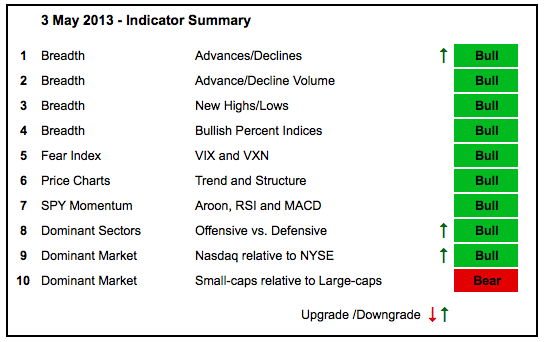Stocks remain resilient both short-term and medium-term. SPY dipped in mid April, but surged in late April and hit a new high. The ETF also dipped on Wednesday, but surged to a new high on Thursday. With this rebound, the AD Volume Lines hit new highs and the cumulative Net New Highs lines extended their uptrends. The Technology SPDR (XLK) and the Consumer Discretionary SPDR (XLY) are leading the pack and this is bullish overall.


- AD Lines: Bullish. The Nasdaq AD Line surged back to its March high and I will now set key support at the April low. The NYSE AD Line hit a new high and remains in a strong uptrend.
- AD Volume Lines: Bullish. The Nasdaq and NYSE AD Volume Lines both moved to new highs this week and the April lows mark key support.
- Net New Highs: Bullish. Nasdaq and NYSE Net New Highs remain firmly positive and their cumulative lines moved to new highs.
- Bullish Percent Indices: Bullish. All nine BPIs are above 50%.
- VIX/VXN: Bullish. The S&P 500 Volatility Index ($VIX) and the Nasdaq 100 Volatility Index ($VXN) are trading near their lows and well below resistance at 20%.
- Trend-Structure: Bullish. SPY, QQQ and MDY hit 52-week highs this week. IWM and DIA did not. Three of the five are clearly bullish and we have yet to see breakdowns.
- SPY Momentum: Bullish. RSI bounced off the 40-50 zone for the third time since December. MACD(5,35,5) has been positive since late November. The Aroon Oscillator is back at +50.
- Offensive Sector Performance: Bullish. XLK and XLY hit new highs this week to lead the market. XLF is stalling, but near its highs and now showing much weakness. XLI fell short of its mid April higher. Relative strength in XLK and XLY is enough to be bullish.
- Nasdaq Performance: Bullish. For the first time in a long time, the $COMPQ:$NYC ratio is bullish as it broke out and hit a high for 2013.
- Small-cap Performance: Bearish. The $RUT:$OEX ratio peaked in mid March and remains in a downtrend with the April highs marking resistance.
- Breadth Charts (here) and Intermarket Charts (here) have been updated.
This table is designed to offer an objective look at current market conditions. It does not aim to pick tops or bottoms. Instead, it seeks to identify noticeable shifts in buying and selling pressure.
This commentary and charts-of-interest are designed to stimulate thinking. This analysis is
not a recommendation to buy, sell, hold or sell short any security (stock ETF or otherwise).
We all need to think for ourselves when it comes to trading our own accounts. First, it is
the only way to really learn. Second, we are the only ones responsible for our decisions.
Think of these charts as food for further analysis. Before making a trade, it is important
to have a plan. Plan the trade and trade the plan. Among other things, this includes setting
a trigger level, a target area and a stop-loss level. It is also important to plan for three
possible price movements: advance, decline or sideways. Have a plan for all three scenarios
BEFORE making the trade. Consider possible holding times. And finally, look at overall market
conditions and sector/industry performance.

About the author:
Arthur Hill, CMT, is the Chief Technical Strategist at TrendInvestorPro.com. Focusing predominantly on US equities and ETFs, his systematic approach of identifying trend, finding signals within the trend, and setting key price levels has made him an esteemed market technician. Arthur has written articles for numerous financial publications including Barrons and Stocks & Commodities Magazine. In addition to his Chartered Market Technician (CMT) designation, he holds an MBA from the Cass Business School at City University in London.
Learn More




